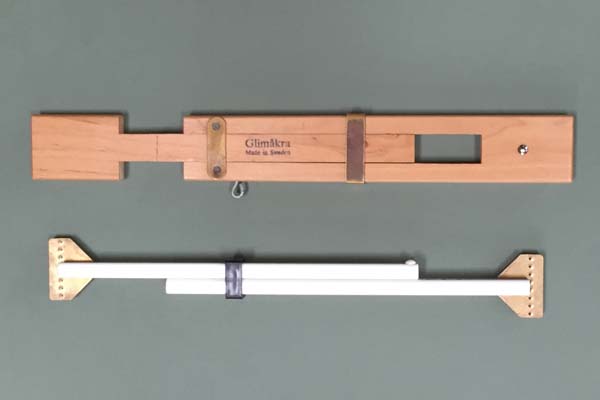I have been weaving for many years and have noticed more and more photos of weavers using temples for all sorts of items. I thought that temples were often used for rugs and wall hangings, but wonder if they are practical for other projects, such as towels. My two questions are: Is weaving with them more time consuming because you have to keep advancing the temple, and does using one affect the ability to establish a “feel” for weaving a straight selvedge? –Charlene
Hi Charlene!
Temples are practical for weaving many different types of fabrics. My usual rule of thumb is to use a temple if my weaving width is more than about twelve inches (unless the materials and setts make the edges too fragile to support a temple’s weight). This is not to say that weavers must use temples; I just find that they contribute to preventing draw-in and minimizing the crowding of warp threads at the selvedges.
Temples do have drawbacks. When they are in place, they cover up the area of cloth that you have just woven. This can prevent you from noticing treadling mistakes that you might have made in that area unless you are careful to check for them each time you advance the temple. (There are some systems that do the same job as a temple by clamping each side of the cloth, pulling the selvedges rather than pushing them to the intended weaving width; these do allow you to see the area you have just woven. I haven’t used them to evaluate whether or not they work as well as standard temples.)
Advancing the temple does add, as you suspect, to weaving time. (This seemed interesting to investigate, so I timed myself. It took fewer than 20 seconds to advance the temple to its next position. Using a temple would therefore add about 9 minutes to each yard of weaving.)
It is important to note that the temple has to be used properly to deliver its main advantages (firm, smooth edges; minimal draw-in). The teeth must be inserted right next to the very last thread on each selvedge. The temple must be sett to the width of the warp in the reed. And most important, enough weft slack must be allowed in the shed to accommodate the over-and-under path the weft will take when it is pressed to the fell. I usually allow about a 30 degree weft angle and beat on a closed shed (which assures that you don’t pull the weft flat as you bring the better forward). If the temple gets harder and harder to place in the cloth, you are not allowing enough weft slack. The temple should be advanced at least every 1½"; I usually advance the temple every 1¼" and the warp every 2½".
I have not found the temple to affect the ability to achieve that intangible feeling you get for just how to move your body, the shuttle, and the beater so that the weft makes a perfect turn at each selvedge. This must be established at the beginning of each project and is why sampling, on the warp intended for the piece, is so important. For this reason, I always recommend putting on a longer warp than is needed for any project and not beginning the actual project until you have practiced enough to get and keep that "feel."
If you are satisfied with the results you achieve now without using a temple, there is certainly no need to start using one. If you decide to give them a try, note that it takes some practice to use them for best results.
–Madelyn
If you have a weaving question please email Madelyn! View related & recent "Ask Madelyn" posts!


